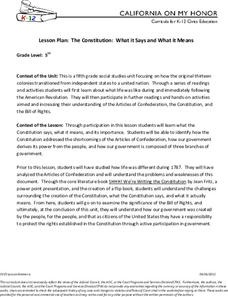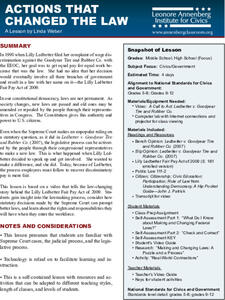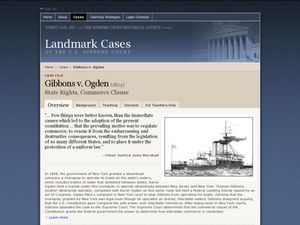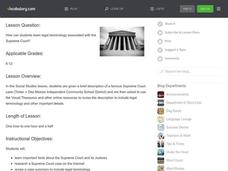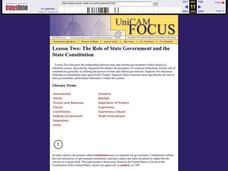Curated OER
Claim Your Jurisdiction Game
Students participate in a game in which they have to decide whether it is state or federal jurisdiction.
Curated OER
Civics: Missouri's Non-Partisan Court Plan
Students examine the ways that the Missouri Non-Partisan Court Plan helps the court maintain a system of separation of powers and checks and balances. After discussing the principle of judicial impartiality, they complete a chart...
Judicial Branch of California
The Constitution: What It Says and What It Means
Learners get the chance to act as representatives to the Constitution Convention, and must decide whether or not to recommend your state ratify the new framework. After examining the Constitution line-by-line, they consider their...
Carolina K-12
Principles of the US Constitution
After breaking into groups according to major principles of government (i.e., popular sovereignty, separation of powers, checks and balances, etc.) in the United States, your class members will produce public service announcements...
Annenberg Foundation
Actions that Changed the Law
The Fair Play Act of 2009 came about due to the actions of one woman. Young historians research Lilly Ledbetter and what she went through to get pay equal to that paid to men for the same work at Goodyear Tire and Rubber Company. The...
Curated OER
The "Big Four"
Learners identify the four individuals who are identified as the "Big Four", examine the years they were on the bench together, and look and the impact they made in key cases.
Curated OER
Supreme Court Decisions and Their Effect On Us
Consider five Supreme Court cases and how their outcomes have directly affected the American population. Government students research and compose a 1-2 page pager outlining the examples of our daily life that have specifically been...
Curated OER
From Tinker to Fraser: Freedom of Speech in Public Schools
The Tinker and Fraser cases were taken the Supreme Court on the basis of the 1st Amendment right to Freedom of Speech. Learners discuss each case, the First AMendment, complete handouts, and conduct a role play activity. Handouts are...
Curated OER
Mueller v. Allen
Students investigate a First Amendment legal case involving religion, education, and reimbursement of tuition payments. They research the background of the cases and its precedents.
Curated OER
What is a Court?
Young scholars examine and discuss the judicial branch of the U.S. government. They define what a court is, list three characteristics of a trial court and an appellate court, and analyze various trial and appeal situations.
Curated OER
Discovering Democracy in Canada: Federal Perspectives
Tenth graders research one aspect of government. They teach their peers co-operatively about the key elements of Democracy in Canada at the Federal Level by giving group presentations.
Curated OER
Gibbons v. Ogden (1824)
Students examine state rights and the commerce clause. In this Supreme Court instructional activity, students examine primary documents from Gibbons v. Ogden and discuss the implications of the decision.
Curated OER
Words That Hold Court
Students recognize the importance of the Supreme Court. In this legal terminology lesson, students define a list of words to understand the Supreme Court and the language used in cases. Students revise a case summary.
Curated OER
Words That Hold Court
Students research legal terminology used in the Supreme Court. In this legal terminology lesson, students study a quote from President Obama about the Supreme Court. Students make a list of facts about the Supreme Court and the justices...
Curated OER
The Role of State Government and the State Constitution
Students investigate the relationship between state and national governments. They define the principles of American federalism how the constitution outlines the powers of state and federal government. Lesson focuses on Nebraska...
Curated OER
Michigan Court System (Part 1) (Middle School)
Students identify the courts that make up the Michigan judicial system. They explore the responsibility of each court and diagram how cases move to the Supreme Court. They compare and contrast the different types of courts.
Curated OER
Full Court Press
Students investigate the Supreme Court's role and function in the federal government and examine how Chief Justice Rehnquist's illness might affect the future of the Court. They write letters to President Bush on the Supreme Court...
Curated OER
Constitution
Ninth graders simulate a U.S. Supreme Court hearing concerning a First Amendment case about school prayer by participating in a hearing.
Alabama Learning Exchange
Read All About It! Supreme Court Case Makes Headlines!
Students are assigned a landmark Supreme Court case to research. They construct a one-page newsletter on the case which include a summary of the case, two pictures and a short biography on one of the justices on the Court at that time.
Curated OER
How Did That Get There?
High schoolers evaluate the role of government in addressing land use and other environmental issues. They analyze the powers, responsibilities, and limitations of elected and appointed officials in the national legislative, executive,...
Curated OER
Eminent Domain: Should Private Property Be Taken for Public Use?
Students explore the concept of eminent domain. For this eminent domain lesson, students analyze positive and negative consequences of Supreme Court rulings in three cases pertaining to the public good.
Curated OER
Landmark Supreme Court Cases and the Constitution: Reynolds v. United States (1878)
Students examine the impact of court decisions. In this Supreme Court lesson, students read the Reynolds v. United States (1878) case study regarding first election decided by the House of Representatives. Students take notes on...
Curated OER
U.S. Constitution - Checks and Balances
Students examine the separation of powers of the branches of the U.S. federal government. For this U.S. Constitution lesson, students listen to a SMART Board supported lecture on checks and balances of the Judicial, Legislative, and...




